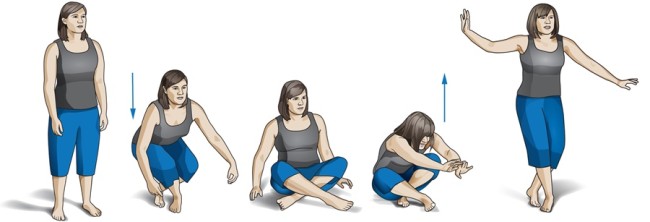Written in conjunction with StrengthCoach Podcast Ep. #302
The “get up” test, also known as the sitting-rising test (or SRT for short) in the scientific literature, is completed as follows:

These two basic movements in the sitting-rising test — lowering to the floor and standing back up — are each scored on a 1-to-5 scale, with one point subtracted each time a hand is placed on a knee, or a hand, knee, forearm, or side of the leg is used for support; for a maximum of 10 points.

In a study(1) done by Brazilian physician Claudio Gil Araujo using this sitting and rising test with more than 2,000 patients ages 51 to 80, he found that those who scored fewer than eight points on the test out of ten, were twice as likely to die within the next six years compared with those who scored higher. Those who scored three or fewer points were more than five times as likely to die within the same period.
And each 1 point increase in the SRT score was associated with a 21 percent decrease in mortality from all causes.
So, what do we do with this information?
First of all, we hope sharing such information will encourage more people to walk through the doors of a gym rather than roll through the doors of a hospital.
Secondly, this makes a case for more ground based movements and pursuing proficiency in the Turkish “Get Up” exercise for both longevity and health.
Let’s start by discussing the Turkish Get Up. The Turkish Get Up, or TGU for short, is much more than a “core” exercise. It places huge demands on strength, stability, mobility and focus. We recommend pausing at every step, taking time to learn that position, and breathe.
Getting off the ground under load like this is unique to each person’s movement index. The movement is going to be determined by things like lever lengths, mobility and strategies. Get Ups are like fingerprints, although they may look similar, no two are exactly the same.
When performing the Turkish Get Up it is very important to progress slowly. Dedicate a few weeks to learning each step of the TGU. Don’t worry about loading early on. Coach Brett Jones suggests “You should perform at least 100 TGUs, on each side, with no load before adding a kettlebell.”
Now, how to sprinkle in more opportunities to get up and get down during a workout…
1. In the warm up.
This following ground-to-standing warm-up circuit will prepare your body for training by improving core muscle sequencing, stabilizing the hip, improving shoulder and thoracic range of motion and increasing body temperature. The routine can be performed entirely with bodyweight but external resistance can be added if you desire to increase the difficulty.
And 2. Up-Down Circuits – a simple programming approach that we learned from coach Dan John, an Up-Down circuit pairs standing exercises with ground based exercises in an alternating fashion.
This is a great way to increase metabolic demand without resorting to dangerous, nonsense exercises like burpees that can be hazardous for the shoulder, wrist and back.
An example Up-Down circuit could be:
Repeat 4 times.
Resources
ARE YOU CERTIFIED YET?
Our Certified Functional Strength Coach Level 1 Online Course is designed to provide you with the same experience you’d get attending our live Level 1 workshop. Complete with the same pre-workshop materials, our Online Course includes a ‘Virtual Live Workshop’, where you will follow a CFSC instructor through an entire Level 1 Workshop complete with instruction, demonstration and question and answer as if you were spending the day at Mike Boyle Strength and Conditioning. Keeping with our rigorous practical standards, all enrollees will be required to complete an online exam and a coaching practical featuring video and open ended questions to complete their certification.